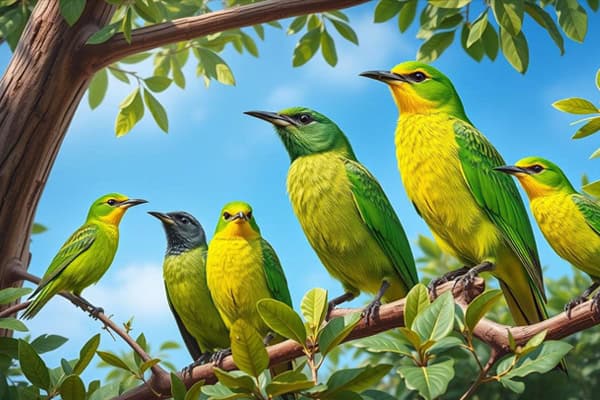Spotting 7 Types Of Finches In Hawaii (With Pictures)
Do you know Finches in Hawaii have some unique characteristics? thought about the colorful and varied finch species living in Hawaii? These islands are remote and volcanic, making them home to many unique, endangered birds. Over 60 unique finch species, not found anywhere else, live in Hawaii, adding to its rich biodiversity. Let’s dive into the fascinating world of Hawaii’s finches and discover the 16 striking types that fly over the islands.
Vibrant Avian Treasures
Hawaii is full of colorful, unique finches. 16 types are living on the islands. Each type is a special bird to see.
The Akekee is at risk, but there are also charming finches like the Anianiau and Apapane. They have unique features, like the Akiapolaau’s special beak. This shows how diverse Hawaii’s finches are.
These birds are more than pretty sights. They are key to Hawaii’s environment. Saving their homes and them is vital. This ensures everyone can enjoy them for years.
Let’s dive into the world of Hawaii’s finches. We’ll look at what makes each species so amazing.
“The finches of Hawaii are a testament to the incredible diversity and adaptability of these birds. Each species is a unique and irreplaceable part of the island’s natural heritage.”
Here we’ll Discuss Different Types of Finches In Hawaii!!!
1. Akekee
- Scientific name – Loxops caeruleirostris
- Lifespan – Unknown
- Size (average) – (10 cm)
- Weight – Unknown
- Wingspan – Unknown
- Status – Critically endangered
The Akekee is a special finch that only lives in Hawaii. It’s known for its unique look and actions. This bird is about 5 inches long and has beautiful colors. The males are bright yellow but have black or dark gray wings. Females are not as brightly colored.
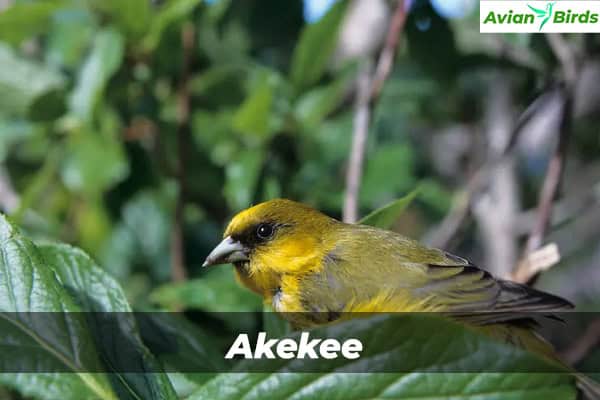
One thing that makes the Akekee interesting is how it finds food. It uses its long, curved bill to pick insects and larvae from tree bark. This tells us it has changed over time to fit into Hawaii’s environment. But, the Akekee is now at risk because its numbers are dropping fast.
In the past 25 years, the Akekee population has fallen by 98%. Just 638 of them were left in 2021. Without help, they might disappear in 5-10 years. Loss of their forest homes and new species coming in are the biggest dangers for the Akekee on Kauai, Maui, and Molokai.
“The Akekee is on the State of the Birds Watch List, and in 2023, nearly $16 million in federal funding was committed to restore populations of dwindling endemic Hawaiian songbirds. Legislation was also supported to reduce the impact of free-roaming cats on Kauai, where the Akekee is found.”
There is hope for the Akekee thanks to conservation work. People are coming together to save the Akekee and other special birds in Hawaii. By working hard and using enough resources, we might be able to keep these birds from disappearing forever.
2. Akiapolaau
- Scientific name – Hemignathus wilsoni
- Lifespan – 13 years
- Size (average) – (14 cm)
- Weight (average) – (28.3 g)
- Wingspan – (18 to 20 cm)
- Status – Endangered
The Akiapolaau Finches In Hawaii are very interesting and live only in Hawaii. It has a special beak, split into two parts. One part is for probing into small places. The other part is for hammering and peeling bark. This special beak helps the Akiapolaau eat many kinds of food, making it able to live in different places.

This bird can live in many parts of Hawaii. This includes native forests, high up in the mountains, and places with small shrubs. Besides its unique beak, the Akiapolaau is great at finding food. It uses its long, thin beak to find insects in bark. At the same time, it uses its short, strong beak to break the bark.
But, the number of Akiapolaau is going down. This is because of losing their homes, new animals coming in, and changes in the weather. To help, people are working to save these amazing birds.
| Statistic | Value |
|---|---|
| Census population size of the Akiapolaau | Approximately 1000 individuals |
| IUCN Red List category for the Akiapolaau | Endangered (B1ab(i,ii,iii,iv,v); C2a(ii)) |
| Number of critically endangered Hawaiian honeycreeper species | 6 |
| Number of endangered Hawaiian honeycreeper species | 4 |
| Number of vulnerable Hawaiian honeycreeper species | 5 |
| Number of Hawaiian honeycreeper species extinct or likely extinct since European arrival | At least 22 |
The Akiapolaau’s special beak and feeding ways show how Hawaii’s birds have changed over time. Even though they’re in danger, people are trying hard to keep these birds around. They are an important part of the many kinds of birds in Hawaii.
Conservation Efforts for the Akiapolaau
The Akiapolaau population is declining. So, many efforts are being made to save this special Hawaiian finch. Various groups, like the Hawaii Department of Land and Natural Resources, are working hard. They are saving the bird’s home, fighting off harmful invaders, and teaching people about why it’s crucial to save this bird.
In the past, the Akiapolaau was all over Hawaii, especially on the Big Island. But since the 1970s, it’s been disappearing. Now, it only lives in the mountains and is at risk of disappearing forever.
At the Hakalau Forest National Wildlife Refuge, essential work is being done. For more than 35 years, they’ve been planting trees to help all the native birds, including the Akiapolaau. They’ve already planted over 600,000 trees! Besides, they are keeping safe 29 species that are on the edge of vanishing, like the Hawaiian honeycreepers.
3. Akikiki
- Scientific name – Oreomystis bairdi
- Lifespan – Unknown
- Size (average) –(13 cm)
- Weight – (12 to 17 g)
- Wingspan – Not Yet
- Status – Critically endangered
The Akikiki, also known as the Kauai Creeper, is found only on Kauai. It has a gray look and a long, thin bill. Sadly, their numbers are very low, mainly due to losing their homes to deforestation and diseases by mosquitoes. Less than 10 of them are alive today, making them very close to disappearing forever.
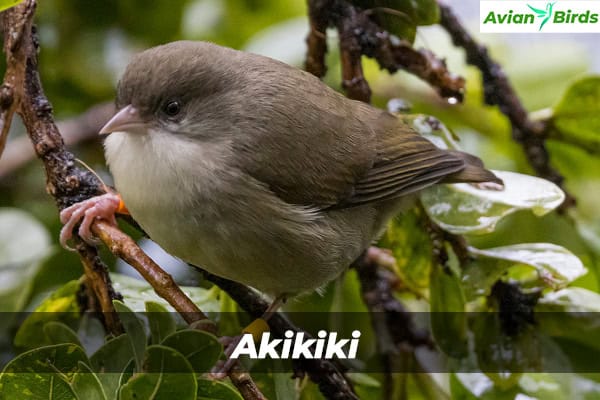
4. Akohekohe
- Scientific name – Palmeria dolei
- Lifespan – 9 years (Mostly record)
- Size – (17 to 18 cm)
- Weight – Unknown
- Wingspan – Unknown
- Status – Critically endangered
The Akohekohe, or Crested Honeycreeper, lives on Maui. It stands out with its bright orange feathers and crest. But, it’s having a hard time surviving, mainly because people have destroyed its habitat. Also, plants not from there have made things difficult. This bird’s story shows why we must act fast to save Hawaii’s birds.
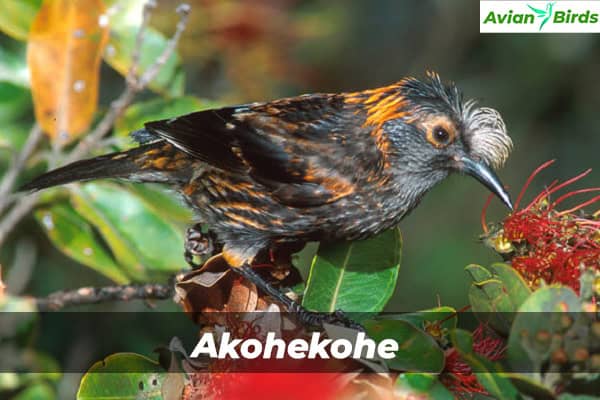
Efforts to save these finches include making their homes better, stopping predators, and helping them have babies in a safe place. These steps target the main dangers they face, like losing their places to live, invasive species, and the changing climate. The goal is to keep Hawaii’s special birds around and not lose these unique creatures.
But it’s not just about these two species. The overall bird situation in Hawaii is getting worse, especially with malaria and mosquitoes that people brought there. More than a dozen honeycreeper birds face extinction because of this. There is hope, though, with the recent big funding from the government to help save the forest birds. Yet, there’s a lot more to do.
Anianiau and Apapane
5. Anianiau
- Scientific name – Magumma parva
- Lifespan – 9 years (maximum recorded)
- Size (average) – (10 cm)
- Weight – (9 to 10 g)
- Wingspan – Unknown
- Status – Vulnerable
The Anianiau male is yellow all over, while the female is yellowish-green. They sing a trill that sounds like “weesee-weesee-wee-see,” and their call is a “su-weet.”
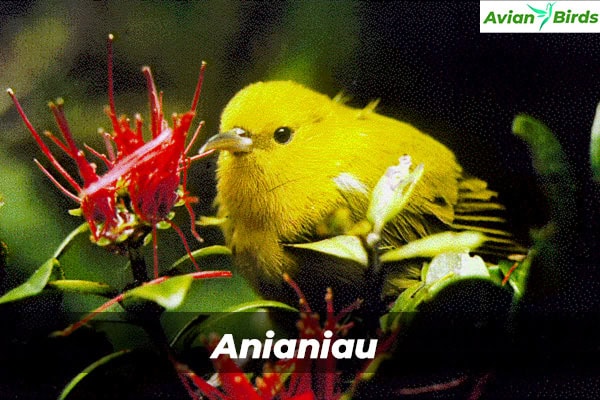
These birds build cup-shaped nests. Their breeding season lasts from February to June, and the female lays up to three eggs at a time.
The Anianiau Finches in Hawaii (Magumma parva) eats insects, spiders, nectar, and fruit.
Although the Anianiau is listed as vulnerable, its population is stable. There are currently about 8,700 Anianiau left. They live in an area that is 85% smaller than it used to be. They are threatened by diseases, habitat destruction, competition with introduced species, and predators.
Read Our Previous Articles:
6. Apapane
- Scientific name – Himatione sanguinea
- Lifespan – 11 years (maximum recorded)
- Size (average) – (13 cm)
- Weight – (14.4 to 16 g)
- Wingspan – Unknown
- Status – Least concern
The Apapane, on the other hand, showcases a brilliant red plumage. Its name means “flycatcher” in Hawaiian. It can be found in many places, from wetlands to gardens across Hawaii.

Both birds help pollinate Hawaii’s native plants. They drink nectar and help plants reproduce by moving pollen. Their presence boosts the islands’ natural beauty and shows off its unique plants.
“The Anianiau and Apapane are true gems of Hawaii’s avian landscape, captivating birdwatchers and nature enthusiasts alike with their vibrant plumage and enchanting songs.”
These finches are more than just pretty. They are vital to Hawaii’s ecosystem. Their work keeps the plant life healthy and diverse. This ensures Hawaii remains a gorgeous place of nature.
Protecting Hawaii’s Vibrant Finch Population
Yet, these birds face big challenges. They’re threatened by losing their homes, invasive species, and climate change. By helping in conservation and choosing sustainable tourism, we can protect Hawaii’s natural treasures.
7. Hawaii Akepa
- Scientific name – Loxops coccineus
- Lifespan – 10 years (maximum recorded)
- Size – (10 to 13 cm)
- Weight (10 to 12 g)
- Wingspan – (6 to 7 cm)
- Status – Endangered
The Hawaii Akepa males are bright orange, while the females are greenish-grey with a yellow band across their chests. Both have a pale beak that crosses at the tip. They sing a trilly song and make a soft “tiddle-ee” call.
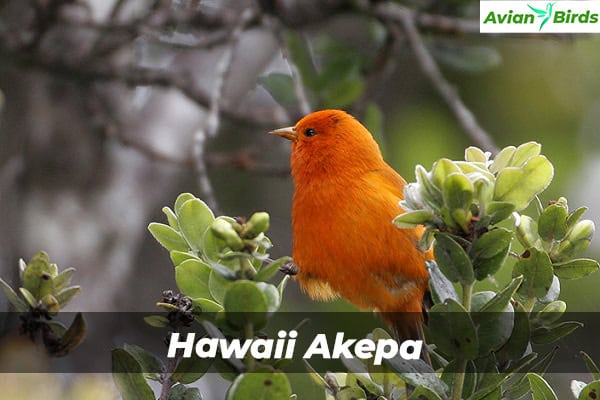
These birds build their nests in the cavities of Ohia and Koa trees. They breed from March to June, and the female lays one or two eggs at a time.
The Hawaii Akepa mainly eats insects.
The Hawaii Akepa (Loxops coccineus) is an endangered bird species that can only be found on Hawaii Island today. In the past, they also lived on Oahu and Maui, but now they are extinct in those places. There are about 14,000 Hawaii Akepa left, and their numbers are going down. They face threats like losing their homes, diseases, and predators.
Frequently Asked Questions About Finches in Hawaii
Q1. What kind of finches are in Hawaii?
Hawaii is home to several finch-like birds known as Hawaiian honeycreepers, which are a group of small, colorful birds adapted to different ecological niches.
Q2. What bird is common to Hawaii?
The common myna, an introduced species, is widespread in Hawaii. Native birds like the ‘amakihi, a type of Hawaiian honeycreeper, are also commonly found.
Q3. How did the finch get to Hawaii?
Finch-like birds, particularly the ancestors of Hawaiian honeycreepers, are believed to have arrived in Hawaii millions of years ago, likely blown off course from Asia or North America by strong winds.
Q4. What is the small green bird in Hawaii?
The small green bird often seen in Hawaii is the Japanese white-eye, also known as the mejiro, an introduced species that is now common across the islands.







